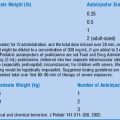Chapter 33 Endocrine Disorders
1 Why are children susceptible to hypoglycemia? What glucose level is considered hypoglycemia? How do you correct it?
Children are susceptible because:
 Glucose utilization is high because of increased metabolic demands.
Glucose utilization is high because of increased metabolic demands.
 Fewer gluconeogenesis precursors are generated because of less fat and muscle mass.
Fewer gluconeogenesis precursors are generated because of less fat and muscle mass.
 A child’s developing brain needs a constant source of substrate.
A child’s developing brain needs a constant source of substrate.
Reid SR, Losek JD: Hypoglycemia in infants and children. Pediatr Emerg Med Rep 5:23–30, 2000.
2 At what point should diagnostic tests for hypoglycemia be obtained? What would they be?
1 Rapid identification is essential.
2 Children are susceptible because of small glycogen stores and high glucose utilization.
3 Treat hypoglycemia as follows: for infants (glucose level < 40 mg/dL), D10W, 2–4 mL/kg; for 1- to 8-year-olds (glucose level < 60 mg/dL), D25W, 2–4 mL/kg; for older children and adolescents, D50W ampule.
3 What is the most common cause of hyperthyroidism in children?
Sills IN: Hyperthyroidism. Pediatr Rev 15:417–420, 1994.
McKeown NJ, Tews MC, Gossain VV, Shah S: Hyperthyroidism. Emerg Med Clin North Am 23:649–667, 2005.
4 Presenting symptoms of hyperthyroidism are commonly attributed to which other body systems or disorders?
Sills IN: Hyperthyroidism. Pediatr Rev 15:417–420, 1994.
McKeown NJ, Tews MC, Gossain VV, Shah S: Hyperthyroidism. Emerg Med Clin North Am 23:649–667, 2005.
5 What is thyroid storm? What is the treatment?
Sills IN: Hyperthyroidism. Pediatr Rev 15:417–420, 1994.
McKeown NJ, Tews MC, Gossain VV, Shah S: Hyperthyroidism. Emerg Med Clin North Am 23:649–667, 2005.
6 If congenital hypothyroidism is missed in the neonatal period, when will signs/symptoms present?
7 How do the adrenal glands respond to stress? What are examples of such body stressors? What do children with adrenal insufficiency and children taking long-term exogenous glucocorticoid therapy have in common?
9 What is the emergency treatment for acute adrenal insufficiency?
Much of the initial stabilization is supportive care. The treatment includes:
 Fluid resuscitation with normal saline (500 mL/m2) for shock and dehydration
Fluid resuscitation with normal saline (500 mL/m2) for shock and dehydration
 Correction of the hypoglycemia with D25W
Correction of the hypoglycemia with D25W
 Hydrocortisone, 2–3 mg/kg via IV route
Hydrocortisone, 2–3 mg/kg via IV route
 Correction of the hyperkalemia (sodium polystyrene sulfonate, glucose/insulin, calcium gluconate, sodium bicarbonate)
Correction of the hyperkalemia (sodium polystyrene sulfonate, glucose/insulin, calcium gluconate, sodium bicarbonate)
 Monitoring of vital signs, cardiac rhythm, perfusion, glucose, and electrolytes
Monitoring of vital signs, cardiac rhythm, perfusion, glucose, and electrolytes
August GP: Treatment of adrenocortical insufficiency. Pediatr Rev 18:59–62, 1997.
10 What is the most common cause of amenorrhea in adolescents?
Braverman PK, Sondeimer SJ: Menstrual disorders. Pediatr Rev 18:17–25, 1997.
12 Why is it difficult to make the diagnosis of type 1 diabetes in early childhood?
Plotnick L: Insulin-dependent diabetes mellitus. Pediatr Rev 15:137–148, 1994.
13 What questions or clinical findings may help you consider type 1 diabetes in your differential diagnosis?
19 How is time a factor in the treatment of DKA?
Lavin N: Manual of Endocrinology and Metabolism, 2nd ed. Boston, Little, Brown & Company, 1994.
Sperling MA: Pediatric Endocrinology. Philadelphia, W.B. Saunders, 2002.
20 What signs and symptoms should make you consider the diagnosis of type 2 diabetes mellitus?
Nesmith JD: Type 2 diabetes mellitus in children and adolescents. Pediatr Rev 22:147–152, 2001.
American Diabetes Association. Available at www.diabetes.org.
21 What is the probable abnormality in type 2 diabetes mellitus?
Nesmith JD: Type 2 diabetes mellitus in children and adolescents. Pediatr Rev 22:147–152, 2001.
1 Children in DKA need skillful correction of electrolyte, metabolic, and glucose abnormalities as well as careful clinical monitoring and reassessment.
2 For children in DKA, try to reduce glucose level at a rate of 50–100 mg/dL/h.
3 When treating DKA, add glucose when the serum level is < 300 mg/dL, but do not discontinue insulin.
22 True or false: DKA is the only acute metabolic abnormality that occurs in children with type 2 diabetes mellitus
American Diabetes Association. Available at www.diabetes.org.
23 Can a child be dehydrated yet still produce copious amounts of urine?
Saborio P, Tipton GA, Chan JCM: Diabetes insipidus. Pediatr Rev 21:122–129, 2000.



